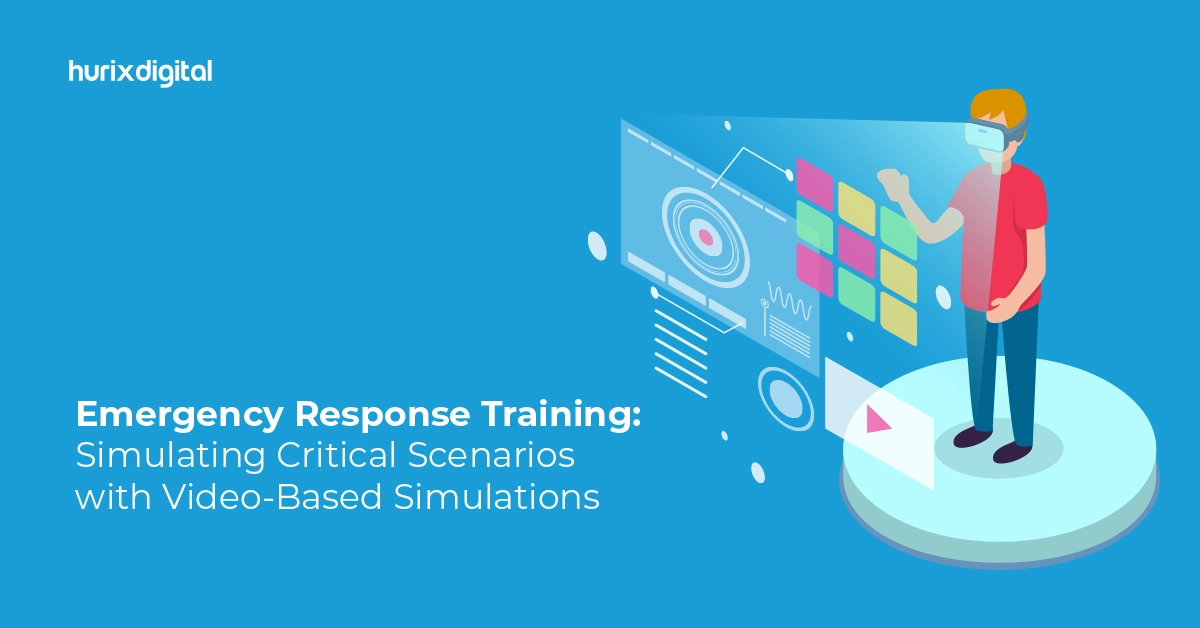Emergency Response Training: Simulating Critical Scenarios with Video-Based Simulations
In the realm of emergency response training, the need for effective and immersive learning experiences is paramount.
Video-based simulations have emerged as a powerful tool for training personnel to handle emergencies with the required skill and confidence.
It is estimated that 37% of respondents said that their employer never held safety drills for medical emergencies, which caused casualties. Video-based simulations can help avoid this by creating a dynamic and realistic environment where trainees can engage in challenging situations, make critical decisions, and hone their response skills in a safe and controlled environment.
Table of Contents:
- What are Video-Based Simulations?
- Different Emergency Scenarios to Explore
- How to Utilize Video-Based Simulations for Emergency Response Training?
- Wrapping Up
What are Video-Based Simulations?
Video-based simulations are interactive training tools that use video footage to simulate real-world scenarios or situations. These simulations can immerse participants in lifelike situations, allowing them to make decisions and experience the consequences of their actions in a controlled environment.
In emergency response training, video-based modules can replicate different emergency scenarios, such as natural disasters, medical emergencies, chemical incidents, fire incidents, and so on. These simulations are pre-recorded videos that depict the scenario unfolding, with actors portraying individuals involved in an emergency.
Also Read: The Role of Artificial Intelligence in Enhancing Medical Training Programs for Employees
Different Emergency Scenarios to Explore
When it comes to healthcare education, video-based simulations can be a game-changer.
Here are some common emergency scenarios that can be simulated using this approach:
1. Natural Disasters
- Earthquake: video-based simulations can stimulate the aftermath of an earthquake, which includes collapsed buildings, trapped victims, and damaged infrastructure.
- Hurricane: The simulations can depict the challenges of evacuating residents, securing property, and also providing shelter to residents during hurricanes.
- Flood: It shows the consequences of flooding, such as submerged vehicles, stranded individuals, and contamination of water.
2. Fire Incidents
- Structured Fire: It can stimulate a building fire and highlight the evacuation process. It can also help in firefighting techniques and search-rescue operations.
- Wildfire: In the case of wildfire, it can show the challenges of containing and extinguishing a wildfire by protecting property and also evacuating the residents.
3. Medical Emergencies
In medical emergencies such as cardiac arrest, trauma, and casualty incidents, video-based simulation training can help assess the injury and its remedy. It can also help coordinate with emergency services for assistance.
4. Chemical and Nuclear Accidents
Chemical and nuclear accidents have very harmful aftereffects. Workers in these settings require specialized training. Video-based simulations can digitally place employees in circumstances like chemical spills and radioactive releases, helping them become familiar with these kinds of situations.
5. Workplace Emergencies
Serious incidents are more likely to occur in workplaces with sensitive areas and heavy machinery. Through the use of video-based stimuli, individuals can be trained to react appropriately in the event of an accident at work.
How to Utilize Video-Based Simulations for Emergency Response Training?
Video simulations have proven to be highly effective emergency response training as they offer immersive scenarios that closely mimic real-life situations.
Given below are different ways to utilize video-based simulations for emergency response training effectively:
1. Scenario Development
The first step here would be to identify critical emergency scenarios that are relevant to the training objectives. These could include natural disasters, medical emergencies, fire accidents, etc. Detailed scripts and scenarios can be developed for each of them.
2. Video Production
High-quality videos can be produced which accurately depict the chosen scenarios. Ensure that the actors, props, and settings used closely resemble real-life situations.
Professional techniques and equipment can enhance the realism of the simulations. This involves meticulous attention to detail to ensure that the scenarios are realistic and effective in conveying the essential training objectives.
3. Inclusion of Interactive Elements
Integrating interactive elements into the videos can engage trainees and encourage active participation. This includes decision points where trainees must choose a course of action, like interactive quizzes to test knowledge or curating scenarios that adapt based on trainee responses.
4. Easy Accessibility
It is pivotal to make your video-based simulations easily accessible to trainees through online platforms or Learning Management Systems (LMS).
Compatibility with various devices, such as desktop computers, tablets, and smartphones, facilitates flexible training delivery. This accessibility allows the trainees to participate in the training sessions at their convenience, regardless of location and time constraints.
Also, incorporating features such as offline access and downloadable content can enable trainees to access content in areas with limited internet connectivity.
5. Constructive Feedback
After each simulation, trainees can discuss their experiences, outcomes, and decisions. Fostering an environment encourages critical thinking and constructive feedback, which enhances skill and learning development in the long run.
This maximizes the effectiveness of video-based simulations in emergency response training, as it provides a structured opportunity for participants to critically analyze their decisions, experiences, and actions during the simulations.
6. Scalability
It is a critical consideration in the development and implementation of video-based simulations for emergency response training.
By designing scalable simulations, organizations can ensure training programs that can accommodate varying numbers of trainees, adapt to changing training needs, and be cost-effective. This involves creating modular simulations that cover different emergency scenarios and skill levels, which helps organizations customize programs based on specific training objectives and requirements of the audience.
7. Immediate Feedback
With the help of video simulations, participants can receive fast feedback and learn from their actions in real time. This immediate feedback loop speeds up and improves learning by assisting students in understanding the effects of their choices.
These could involve post-simulation quizzes, skill assessments, and stimulating exercises to evaluate how well trainees apply their knowledge and skills to practical scenarios.
Also Read: Customized Assessments to Help Evaluate Competencies and Progress in Healthcare Education
Wrapping Up
Video-based simulations represent a transformative approach to emergency response training, offering a dynamic and immersive learning experience that closely mirrors real-life scenarios.
If you are looking for an e-learning platform where you can learn about emergency response training, Hurix Digital can help. With Hurix Digital’s expert guidance, you can gain access to high-quality video-based simulations and interactive modules designed to enhance your skills and knowledge in emergency response.
Contact us today!

Senior Vice President
A Business Development professional with >20 years of experience with strong capability to sell new solutions and develop new markets from scratch. New Market Entry Specialist with experience working in the largest emerging markets. Exceptional experience in conceptualizing, ideating and selling new learning technologies like VR AR, etc. across multiple industry verticals.









